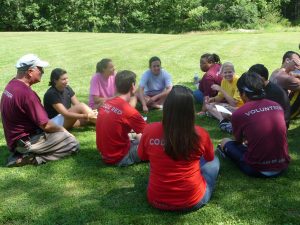and Other Rules for Choosing the Right Games for the Right Time
From Are You Playing with Me
By Leigh Anne Jasheway-Bryant
If you’re in charge of a presentation, whether you’re a professional speaker, a volunteer coordinator, a trainer, or someone who was bribed with a cookie, a big part of your job is to create a safe and playful atmosphere in which fun things can happen. Your goal is to find ways to help everyone in the audience feel comfortable enough in the space, with you, and with everyone else to take a few steps outside their comfort zone. They won’t do that unless they feel secure doing things that they might otherwise consider too risky.
If your audience consists of people who not only work with another, but also FOR some of the people sitting next to them, your job can be made a little more difficult. After all, maybe John Deere over there doesn’t want his boss Betty Crocker to see him talk like a pirate three days before his performance evaluation. There are positives and negatives to having employees and managers in the same room at the same time, but when it comes to playing games, if you have any say in the matter, you might want to suggest separate sessions for each.

Doing Improv at a Conference
No matter what the composition of your audiences (mine are mostly carbon-based), you’ll find it easier to help everyone enjoy themselves and play well with others if you keep the following rules in mind.
Rule # 1: Not everyone wants to play.
As young kids, even if we’re shy, we usually want to be part of the game (unless it’s dodge ball and we’re the target). Unfortunately, many adults are much more hesitant to join in the fun. Shyness is one reason. Another is the potential of embarrassing ourselves in front of co-workers, friends, or even strangers. After all, what if we say or do something that gets back to our boss or people we feel we need to impress? Then there’s the issue that the older we get, the more voices we’re likely to have in our heads telling us things like, “Act your age,” “That’s not appropriate,” and “We don’t pay you to have a good time.”
As an educator, speaker, or trainer, one of the worst things you can do is to force someone into a situation he or she really doesn’t want to be in. By scaring them, you shut down their willingness to hear your messages and you may even create tension among the rest of the group. On the other hand, it is your job is the try to encourage everyone to participate at some level and to push a little beyond their comfort zone. After all, things aren’t much fun in the box (or in the cubicle).
The best way to deal with reluctant participants is never to put them in situations where they have to play alone. Don’t “volunteer” them – or let one of their office mates do so – for games in which they have to be the one (or one of a few) in the spotlight. By making sure to have enough games that involve everyone in the group in your bag of tricks, you can encourage the shy and frightened to play along without feeling overly- anxious or, worse, leaving the room.
Rule # 2: Bribes and rewards are effective tools.
Let’s face it, we’re all more willing to take risks and make fools of ourselves if we get something for our effort. It doesn’t have to be something big or expensive – I’ve found that cheap, fun toys I’ve bought at garage sales or secondhand stores are always the most popular. Once I bought a box of Freud Action Figures (they didn’t do anything and the irony amused people. But they did come in funny packaging.)They were one of my most popular “enticements.” As were yellow smiley balls that stuck their tongues out when you squeezed them (which were discontinued because the tongues could fall off and pose a choking hazard to children and immature adults). I personally like getting most of my rewards at garage sales because I’m recycling instead of producing more waste that the planet has to somehow accommodate. Yesterday’s Happy Meal toy becomes today’s corporate bribe.
Even better, most of the time you don’t even have to give away “stuff.” Simply rewarding volunteers and participants with cheers and applause can encourage other volunteers to step up for the activities following. Most people so rarely get cheered on for anything they do, the feeling they get when hearing clapping and congratulatory hoots and whistles is something they’ll take with them into the rest of their day, if not their week.
Rule # 3: Don’t ask anyone to do things you wouldn’t do.

Leigh Anne Jasheway
If you’d be uncomfortable crawling on the floor mooing like a cow, imagine how people whose job doesn’t involve regularly doing crazy things will feel. At no point can the members of the group feel like you’re making fun of them. You should be making fun with them.
It helps if you dress comfortably and playfully, so it appears from the very start that you are there to play with them. It also helps for you to have a choice of activities ranging from those that are only moderately silly and playful to those that are extremely both. You can judge the mood of the group and pick activities that fit in best with their needs and the willingness of their spirit.
Rule #4: The more participants are invested before you start, the more likely they are to take part.
If you come in, set up, and start right in, there becomes a “You” and “Us” division. You’re in charge and they have to go along for the ride. While this is true in some ways, you can put a little more power in their hands by inviting them to play a more active role before things begin.

Attendees helping with setup
Many of the games in this book involve props and supplies. Ask for help in distributing these and laying them out. If the room isn’t set up the way you want it – and if there have been serious speakers prior to your session, it probably won’t be – engage those members of the group who are willing to help you rearrange things. If you don’t have someone assigned to introduce you, ask two people to read your prepared intro as a duet. All of these activities help set the groundwork for fun and help group members feel more connected to you and to the activities you have planned.
Another way to involve participants is to give them some choice or control over the games. This is one reason certain improv games – the ones that don’t require too much comedic skill and thereby intimidate people – are good to include in your bag of tricks. They encourage the audience to play an active role in deciding how the game goes. You can also let participants help choose which activity to try (I usually offer selection up front and let them pick) or give them options for which rules to follow and which rules to break. Any time you can involve participants in decision-making (a serious and professional task), you will increase their comfort in taking part in the games (a light-hearted and fun task).
Rule # 5: Play along, but don’t save all the good roles for yourself.
By being part of certain games, you prove that you’re willing to do what you’re asking them to do (see Rule #3).And when you have people who are reluctant to volunteer, joining in yourself may help them get the courage to raise their hands.
But if you take part in every game, you set a bad precedent by not involving the audience as much as you should and not sharing the fun. Be available only as an emergency back-up volunteer.
Rule # 6: Time is important, even when having fun.
If you don’t allow enough time for everyone to feel like they’ve completed an activity, you create dissatisfaction and feelings of a lack of completion in the room. On the other hand, too much time can make even fun games seem to drag on forever and drain the joy out of them.
If you have a large group, you may find that a certain amount of time is too little for some and too much for others. You will have to choose a happy medium. Ask each team how far along they are and when most teams are done or almost done, announce two or three more minutes. Stick to your time limit, even if one last team still has work to do.
Rule # 7: The later in the day, the harder it is for most people to think on their feet, be creative, or muster the energy to volunteer for activities.
After six or seven hours sitting, the blood and oxygen in our bodies heads south, towards our hips. If you spend most of your day in the seated position and notice your hips have gotten larger, don’t think of it as middle-age spread, think of it as oxygen surplus.
In order for us to feel and be creative and productive, we need oxygen feeding our brain. That’s hard when it is constantly being pulled in the opposite direction by gravity. Quick solutions to this problem include standing on your head, jogging around room, or deep belly-laughing. But be aware of the natural lethargy that happens around 3:00 p.m., especially if a conference or training began early in the morning and adapt your choice of activities accordingly.
Rule # 8: Make sure you know what purpose your games serve.
Just like the coordinator or manager you had to talk into allowing you to use a more playful approach to your topic, there will probably be some people in the audience who need rational, logical explanations of why they should behave in a manner that they consider odd and unprofessional. Even if the reasons is simply to have fun, always be prepared to share why you’re asking them to do something with those who feel more comfortable knowing.
Rule #9: Make time for contemplation and learning.

Discussing the games played.
Games are fun and entertaining, but are only good learning tools if there’s time to reflect on what the lessons were. In addition to allowing time for each activity in this book, I recommend building in time between activities so participants can process what they’ve learned and recharge.
Bonus Rule #10: Anything worth saying is worth singing.
It just is.


